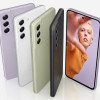Hands On: LG L7, L5, and L3
Feb 26, 2012, 2:21 PM by Eric M. Zeman

LG this week outed the L Series, a lower-cost batch of phones that aren't supposed to skimp on style in order to reach their affordable prices. Did LG succeed?
source: LG
L7
The L7 is clearly the best of this trio of Android smartphones from LG. It's display is far superior to the others, as is its overall fit, finish, and materials.
It's a rather blocky phone, with pronounced corners. It is pleasantly light, though, and is comfortable to hold on to. I like the pattern on the battery cover and the controls all worked well and didn't get in the way of usability. It looks rather simple, but the hardware "Home" button at the bottom us really easy to find/use and that makes me happy.
Since the L7 is an Android 4.0 phone, it only needs three buttons, so there are two capacitive buttons on either side of the physical home key. They worked well, too.
This display looks excellent. It's not quite as spectacular as the display of the 4X HD, but it isn't far off, either. It's very bright, clear, and razor sharp. The colors really pop. The photos I saw and videos I watched looked great, especially some HD content that was stored on the phone.
The L7 may be stuck with a dual-core processor, but it was powerful enough so that the user interface was quick. I didn't notice any lag or stuttering when switching between apps and screens.
Speaking of the user interface, the L7 has only the slightest of skins from LG and overall feels clean and free of clutter.
It's a decent little phone, though LG hasn't said if it might show up on any U.S. carrier shelves.
L5
The L5 is a step down from the L7 in pretty much every respect. It is smaller, has a smaller, lower-rez display, isn't quite as pretty, and feels slightly cheaper.
It's a monoblock phone and has an OK feel in the hand. It, too, has pointy corners, but still manages to sit in the hand OK. I found the power/screen lock button to be good, but the volume toggle was a bit soft. The L5 also has a physical home button and capacitive back and menu keys to either side.
The display is what you'd expect from a middle-of-the-road device. It looks good, but doesn't necessarily take your breath away — at least as far as resolution is concerned. It is still plenty bright and colorful.
The user interface is Android 4.0 and the same user interface treatment from LG. I didn't notice and performance problems with the L5 in the time I spent with it. There are some LG-branded applications, but no operator software is on board.
For the consumer who wants a mid-range handset, the L5 could be a contender, though I've see better devices in this segment.
L3
The L3 brings up the rear in LG's recent announcements. Everything about it screams "entry-level." Not that there's anything wrong with inexpensive smartphones, but this is clearly a case of getting what you pay for.
The L3 is more compact than the L7 or L5, probably by 20 or 25%. With a much smaller footprint, it is easier to hold onto and carry about. The materials are not all that great, but the build quality was fine. I liked the feel in the hand for the most part.
The display is quite cruddy. At this point, it is hard to look at 360 x 480 displays and be pleased. The pixels are so obvious they nearly poke you in the eye. It's not that bright, either, and the colors are a bit muted.
The L3 also runs Android 2.3 instead of Android 4.0. With Android 2.3 and LG's older user interface, it felt a little bit slow and laggy.
That's it as far as LG is concerned.
Comments
No messages









































 LG Optimus Zone and Exceed Hit Verizon Prepaid
LG Optimus Zone and Exceed Hit Verizon Prepaid
 Boost Mobile Announces the LG Venice
Boost Mobile Announces the LG Venice
 U.S. Cellular Trots Out the LG Splendor
U.S. Cellular Trots Out the LG Splendor
 Samsung Revives S21 Fan Edition
Samsung Revives S21 Fan Edition
 LG Splendor / Venice / Optimus Showtime
LG Splendor / Venice / Optimus Showtime



